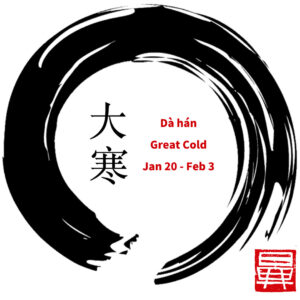
REMINDER OF WHAT THE SOLAR TERMS ARE:
The 24 solar terms consist of 12 major (sectional) terms, each encompassing two minor (middle) solar terms. These terms delineate a complete orbit of the sun, dividing it into 24 segments, each spanning approximately half a month. Their primary function is to mark the progression of seasons, monitor weather patterns, and note natural variations.
The traditional lunisolar calendar is divided into twenty four periods that align with the seasons. These solar terms, which are based on the sun’s position in the zodiac, help us live in synchronicity with nature.
The purpose behind these solar terms is to establish a timeframe for farmers to plan crop production, agricultural activities, and daily life, including the scheduling of festivals. This division aligns with the sun’s annual motion in the ecliptic plane, forming an integral part of the traditional Chinese calendar zodiac.
Significance of the 24 Solar Terms
The 24 Solar Terms serve as indicators of yearly changes in seasons, climate shifts, and agricultural production. This underscores the wisdom of the Chinese in effectively categorizing seasons, impacting commerce, livelihoods, and essential human needs such as housing, food, clothing, and transportation.
Seasonal Changes
Terms like The Start of Spring, the Start of Summer, the Start of Autumn, and the Start of Winter signify the transition between the four seasons. The Spring Equinox, Autumnal Equinox, Summer Solstice, and Winter Solstice mark pivotal moments in the sun’s altitude changes.
Climate Variations
Solar terms such as Slight Heat, Great Heat, Limit of Heat, Slight Cold, and Great Cold reveal temperature fluctuations during different periods. Rain Water, Grain Rain, Light Snow, and Heavy Snow indicate the timing and intensity of rainfall and snowfall. White Dew, Cold Dew, and Frost’s Descent represent the gradual decrease in temperature.
Natural Phenology
Grain Full, Grain in Ear, Awakening Insects, and Pure Brightness mirror natural phenological events, studying the timing of biological occurrences in plants and animals.
Origin and History of the 24 Solar Terms
During the Spring and Autumn Period (770-476 BC), ancient Chinese ancestors established initial solar terms like Summer Solstice and Winter Solstice, denoting “Sun North Most” and “Sun South Most,” respectively. By the end of the Warring States Period (475-221 BC), the four seasons were distinguished: The start of Spring (Spring Equinox), the Start of Summer (Summer Solstice), the Start of Autumn (Autumnal Equinox), and the Start of Winter (Winter Solstice).
Eight key solar terms were introduced, based on the sun and moon’s positions at the beginning and middle of a month, as well as climate and natural phenomena. The Western Han Dynasty (206 B.C.-24 A.D.) saw the completion and official designation of the 24 solar terms, primarily referencing the climate of Xi’an, the capital at that time. These terms have been seamlessly integrated into the Gregorian Calendar and continue to be relevant in contemporary usage.
24 Chinese Solar Terms in Season
Traditionally, the pace of Chinese people’s life was rhythmed by the 24 Solar Terms, which divide each lunar month into 2 segments based on the sun’s movement. Chinese farmers schedule their farming work according to these seasonal turning points.
It is a great invention that has ensured people in China are adequately fed and that Chinese civilisation is able to continue and upgrade for thousands of years.
On November 30, 2018, the 24 Solar Terms were added to the UNESCO list of Intangible Cultural Heritage of Humanity.
Dà Hán = Major Cold = January 20 — February 3
Dà Hán or Major Cold, is considered the coldest time of year. During this time, the body is particularly susceptible to cold and flu due to a naturally weaker Yang Qi. Even though Yang is slowly returning, Yin is still very much in dominance.
Major Cold – the 24th of 24 Chinese Solar Terms
It stars between January 5 and 7 when the sun reaches the celestial longitude of 300°.
This term marks the end of an annual circle.
Suggestions from Chinese Medicine for this Season:
During the solar term of Greater Cold (January 20 – February 3, 2024), which marks the coldest period of the year, consider incorporating the following health suggestions based on traditional wisdom:
1. Keep Warm: Dress in layers to retain body heat and protect against the cold. Ensure your living and working spaces are adequately heated.
2. Nourishing Foods: Consume warm and nourishing foods to support your body in combating the cold. Include hearty soups, stews, and hot teas to provide warmth from within.
3. Hydration: Stay well-hydrated despite the cold weather. Opt for warm water or herbal teas to maintain internal balance.
4. Protect Extremities: Pay extra attention to keeping hands, feet, and head covered to prevent heat loss.
5. Rest and Rejuvenate: Take sufficient rest and prioritize a good night’s sleep to support overall well-being during this cold period.
6. Gentle Exercise: Engage in gentle exercises to promote circulation and warmth, such as tai chi or yoga.
7. Moisturize: Combat dry skin by using moisturizers to keep your skin hydrated.
8. Boosting Immunity: Consume foods rich in vitamins and minerals to support your immune system during the cold season. Consider herbal supplements or teas known for immune-boosting properties.
9. Mindful Practices: Practice mindfulness and stress-reducing activities to maintain emotional balance. Engage in activities like meditation or deep breathing exercises.
Remember, these suggestions are general and may vary based on individual health conditions and local climates. It’s always advisable to consult with healthcare professionals for personalized advice. You can schedule below.
Share this Page: